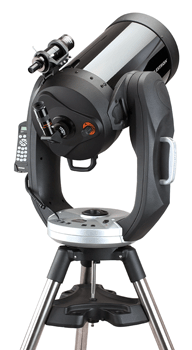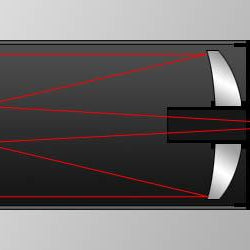
Which Telescope is Best for Me?
As you might imagine, there is no simple answer to this question. The first thing we ask someone when they come into Starizona to shop for a telescope is "What do you want to do with the telescope?" Deciding what...

As you might imagine, there is no simple answer to this question. The first thing we ask someone when they come into Starizona to shop for a telescope is "What do you want to do with the telescope?" Deciding what...

Above: Optical layout of a typical refractor When most people think "telescope" they think of a refractor. The very first telescopes, including Galileo's, were refractors. In fact, all telescopes were refractors until Isaac Newton invented the first reflecting telescope in...

Above: Optical layout of a typical Newtonian For sixty years after the invention of the astronomical telescope, all telescopes were refractors. However, refractors suffer from chromatic aberration because the different colors of light do not focus to the same point....

Above: Typical Dobsonian telescope A Dobsonian telescope is optically identical to a Newtonian telescope; the difference is in how the telescope is mounted. A Dobsonian has a lazy-Susan type base that swivels left and right, and the telescope rides on...

Above: Optical layout of a typical Schmidt-Cassegrain Schmidt-Cassegrains telescopes (SCTs) have become one of the most popular types of telescopes. This is due to the versatility and compactness of the optical design. SCTs are only about twice as long as...

Above: Optical layout of a typical Maksutov-Cassegrain Maksutov-Cassegrain telescopes are an alternative design to the similar Schmidt-Cassegrain telescope (SCT). While similar in most respects, there are a couple differences that have prevented Maksutov-Cassegrains from becoming quite as popular as SCTs....

Above: Optical layout of a typical Schmidt-Newtonian Schmidt-Newtonian telescopes are a modified version of a standard Newtonian. They incorporate a Schmidt corrector lens like that found on aSchmidt-Cassegrain telescope. This lens minimizes some of the aberrations associated with a standard...

Above: Optical layout of a typical Ritchey-Chrétien, with CCD camera attached Ritchey-Chrétiens have become popular in recent years for deep-sky imaging. They are intended primarily as photographic instruments and are not as well-suited to visual observing, but for imaging smaller...

Refractors, Newtonians, and Schmidt-Cassegrains are the most popular telescopes for amateur astronomers. Maksutov-Cassegrains andRitchey-Chrétiens are also reasonably common, with catadioptric Newtonians (Schmidt-Newtonians and Maksutov-Newtonians) growing in popularity for certain applications. For most general-purpose observers, these types of telescopes offer everything...

In the past, most telescopes used a German equatorial mount (GEM). With the advent of computerized telescopes, there are more convenient ways to mount telescopes, but the German equatorial still has many advantages and is still quite common. Above: A...

Fork mounts have become very common for their versatility and ease of use. German equatorial mounts (GEMs) used to be more common, but the advent of computerized telescopes has made the fork mount usable for a variety of applications and...

A Dobsonian telescope incorporates a Newtonian optical design on a unique alt-azimuth type of mount. These telescopes are very popular for both beginners and advanced observers. Above: A typical Dobsonian telescope There are two basic categories of telescope mounts: alt-azimuth...